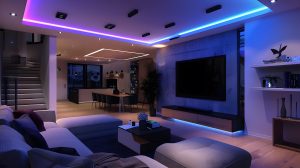
Installing smart lights in your home can contribute to your emotional well-being.
The diverse colours of smart lights could be beneficial to your emotional well-being. The colours in your home can significantly influence your mood and mental

There is no denying that it gets hot in Western Australia. In a typical summer season, heat waves with temperatures up to 40 degrees Celsius is quite the norm. So much so, that in WA more than 93% of Perth homes are smart air conditioning. That’s a lot of homes, and a lot of energy being used to keep thousands of households cool and comfortable.
With so much reliance on heating and cooling, and Australia’s electricity prices rising, it only makes sense that you should look for ways to reduce your energy bills. Approximately 26% of household energy costs can be attributed to air conditioning – but it’s not all bad news.
As with all home products on the market, there’s choice, and air conditioning is no different. There’s many brands, models, sizes and features to choose from. However, if cost efficiency is the number one priority, then a smart air conditioning system should be at the top of everyone’s shopping list.
An iZone smart air conditioning system will provide you with an energy-efficient solution for your home cooling needs. iZone’s clever sensing thermostat, power monitoring system and iSave feature make it a stand-out in the current market.
iZone’s moving sensor doesn’t remain in one location – it constantly moves around the home depending which zones are on and which zone is deemed to be the controlling sensor (the one that is furthest from the requested set point temperature). If just one room or zone is on, then the system will only cool that room until it is satisfied or has reached its set point and then just like a single room wall split unit, it will signal the compressor to wind back and ultimately shut down.
iZone’s smart power monitoring allows you to monitor how efficient appliances are, when they may be operating and how their usage during a 24-hour cycle impacts the amount of energy being consumed relative to daily billing tariffs. Appliances can then be scheduled to run at times to exploit the lowest tariffs on any given day, thereby saving on household energy bills.
iSave is an integrated night cooling/economy cycle system, for small ducted reverse cycle systems. iSave draws cool outdoor air in the evening instead of using the air conditioning unit, saving you thousands in energy consumption and associated running costs. It’s halfway between an evaporative system and a reverse cycle system but still provides the full benefit of ducted reverse cycle when it’s needed.
Traditional systems chew up a lot of energy because they must be manually controlled and don’t have the capability to monitor the temperatures in each room or adjust based on climate and other factors. Even newer air conditioning systems that have a digital temperature sensor still only control the temperature in a home from a single access point. This is ineffective because depending on the location of the thermostat, it may not be taking accurate readings of the temperature in a home.
With less control and the inability to monitor exact temperatures throughout the house, you may be wasting a lot more energy than you realise. It’s time people looked at investing more money to save costs over the long run.
The solution is simple – a smart climate control system! Control temperatures remotely from a mobile phone, set up reminders, set daily schedules or temperature changes based on the outdoor climate, but most of all, enjoy the cost savings!

The diverse colours of smart lights could be beneficial to your emotional well-being. The colours in your home can significantly influence your mood and mental

What is a Smart Home? You wouldn’t be alone if you’re confused by all the ‘smart’ jargon in the industry today. To put it simply,